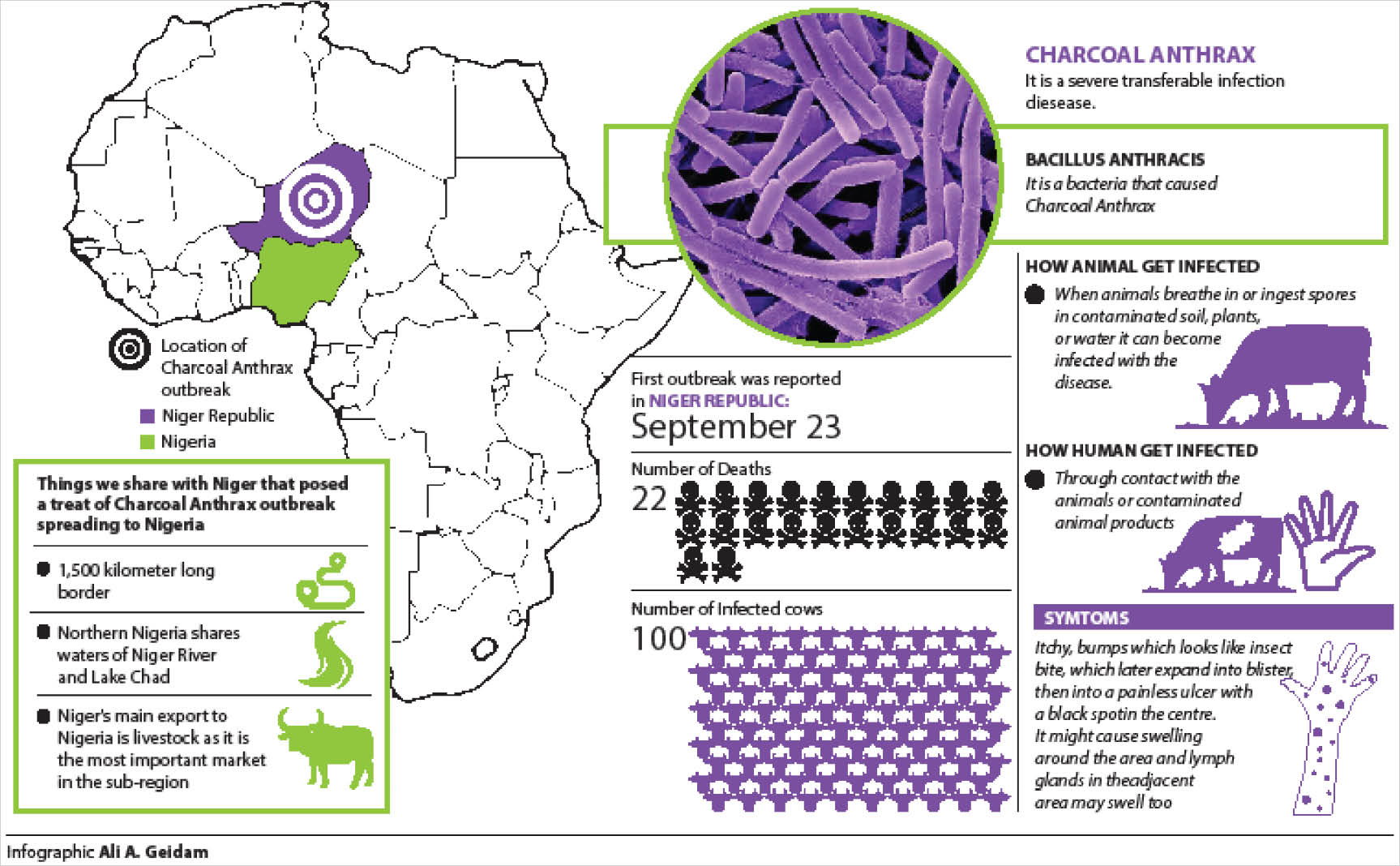Charcoal Anthrax outbreak: What you need to know
Recently, a memo from the Nigerien Ministry of Agriculture and Livestock informing the World Health Organisation for Animal Health (WOAH) of the outbreak of Charcoal anthrax disease triggered fear of outbreak in neigbouring Nigeria, in view of the fact that animals are not barred from crossing the border. The outbreak was first reported in Niger […]

Recently, a memo from the Nigerien Ministry of Agriculture and Livestock informing the World Health Organisation for Animal Health (WOAH) of the outbreak of Charcoal anthrax disease triggered fear of outbreak in neigbouring Nigeria, in view of the fact that animals are not barred from crossing the border.
The outbreak was first reported in Niger Republic on September 23, killing 22 and infected 100 cows.

The development also triggered warning from the Nigerian Customs Service. It said: “Headquarters is in receipt of a report which reveals that the Nigerien Ministry of Agriculture and Livestock had notified World Organisation for Animal Health (WOAH) of an outbreak of Charcoal Anthrax disease, Bacterium Bacillus Anthracis variant, in sheep and cattle in the country.
“Given the supply of cattle and sheep from Niger to Nigeria the CGC has directed on the urgent need to place additional precautionary measures to prevent the spread of the disease into Nigeria through our land borders,” the statement reads in part.
What charcoal anthrax is
It is a severe transferable infection caused by bacteria known as Bacillus anthracis. Anthrax disease can be found in the soil and easily affects livestock and even domestic animals globally. Humans can get infected with anthrax if they come in contact with animals or contaminated animal products infected with the disease. It can cause severe illness in both humans and animals.
How livestock are infected
When a cow, sheep, goat or other animal breathe in or ingest spores in contaminated soil, plants or water it can become infected with the disease.
The Canadian Beef Research Council stressed that “Once spores have been ingested, they infect macrophages (cells that are formed by the immune system in response to an infection), germinate and begin to multiply. The cells then produce a lethal toxin that kills body cells and causes excess fluid to accumulate in body tissues. Once the bacteria begin to multiply in the lymph nodes, the level of toxins in the body increase rapidly and cause tissue damage and organ failure. It is believed that the disease symptoms only last for 2-3 hours, so the most common symptom is sudden death.”
How humans can become infected
According to the United States Centre for Disease Control And Prevention, “People get infected with anthrax when spores get into the body. When anthrax spores get inside the body, they can be “activated.” When they become active, the bacteria can multiply, spread out in the body, produce toxins (poisons), and cause severe illness.
“This can happen when people breathe in spores, eat food or drink water that is contaminated with spores, or get spores in a cut or scrape in the skin.”
One can also become infected by working on animals or animal products like hide and skin that are already infected by the disease.
If you eat raw or undercooked meat from infected animals, one stands a serious risk of getting infected with gastrointestinal anthrax.
The US CDC particularly warned that “countries where livestock are not routinely vaccinated against anthrax and food animals are not inspected prior to slaughter” stand high risks of the outbreak.
If you’re infected, this happens
Cutaneous anthrax usually starts with the skin. It starts as itchy bumps which looks like insect bite, which later expand into a blister, then into a painless ulcer with a black spot in the centre. It might cause swelling around the area and lymph glands in the adjacent area may swell too. If you’re not treated, chances are that you may die of the disease.
If you eat contaminated meat and got infected with intestinal anthrax, symptoms may include: vomiting, loss of appetite fever, nausea, abdominal pain, vomiting of blood and severe diarrhoea. Reports said 60% people may likely die with intestinal anthrax without treatment.
No charcoal anthrax in Nigeria – FG
The Federal Government said it has strengthened surveillance in all the frontline states where cattle markets and cross border activities exist with Niger Republic.
The Director of Veterinary and Pest Control Services, of the Federal Ministry of Agriculture and Rural Development, Dr Olaniran Alabi, told Daily Trust on Sunday through a telephone conversation that the federal government has not received any information from it surveillance system of any outbreak.
